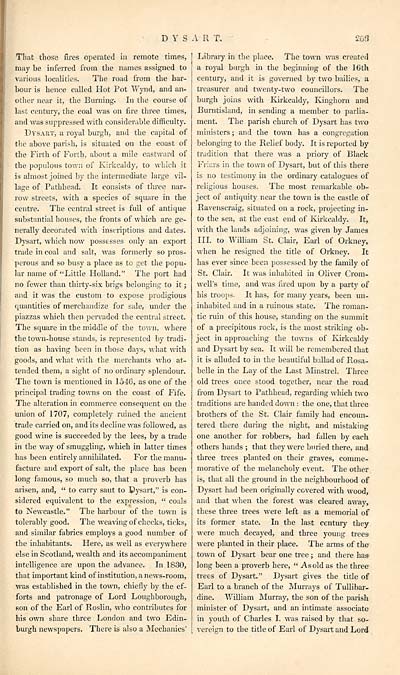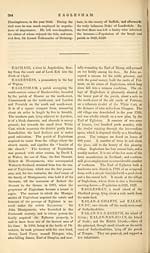Gazetteer of Scotland > Volume 1
(295) Page 263
Download files
Complete book:
Individual page:
Thumbnail gallery: Grid view | List view

D Y S A 11 T.
20a
That those fires operated in remote times,
may be inferred from the names assigned to
various localities. The road from the har-
bour is hence called Hot Pot Wynd, and an-
other near it, the Burning. In the course of
last century, the coal was on fire three times,
and was suppressed with considerable difficulty.
Dysart, a royal burgh, and the capital of
the above parish, is situated on the coast of
the Firth of Forth, about a mile eastward of
the populous town of Kirkcaldy, to which it
is almost joined by the intermediate large vil-
lage of Pathhead. It consists of three nar-
row streets, with a species of square in the
centre. The central street is full of antique
substantial houses, the fronts of which are ge-
nerally decorated with inscriptions and dates.
Dysart, which now possesses only an export
trade in coal and salt, was formerly so pros-
perous and so busy a place as to get the popu-
lar name of "Little Holland." The port had
no fewer than thirty-six brigs belonging to it ;
and it was the custom to expose prodigious
quantities of merchandize for sale, under the
piazzas which then pervaded the central street.
The square in the middle of the town, where
the town-house stands, is represented by tradi-
tion as having been in those days, what with
goods, and what with the merchants who at-
tended them, a sight of no ordinary splendour.
The town is mentioned in 1546, as one of the
principal trading towns on the coast of Fife.
The alteration in commerce consequent on the
union of 1707, completely ruined the ancient
trade carried on, and its decline was followed, as
good wine is succeeded by the lees, by a trade
in the way of smuggling, which in latter times
has been entirely annihilated. For the manu-
facture and export of salt, the place has been
long famous, so much so, that a proverb has
arisen, and, " to carry saut to Dysart," is con-
sidered equivalent to the expression, " coals
to Newcastle." The harbour of the town is
tolerably good. The weaving of checks, ticks,
and similar fabrics employs a good number of
the inhabitants. Here, as well as everywhere
else in Scotland, wealth and its accompaniment
intelligence are upon the advance. In 1830,
that important kind of institution, a news-room,
was established in the town, chiefly by the ef-
forts and patronage of Lord Loughborough,
son of the Earl of Roslin, who contributes for
his own share three London and two Edin-
burgh newspapers. There is also a Mechanics'
Librai-y in the place. The town was created
a royal burgh in the beginning of the 16th
century, and it is governed by two bailies, a
treasurer and twenty-two councillors. The
burgh joins with Kirkcaldy, Kinghorn and
Burntisland, in sending a member to parlia-
ment. The parish church of Dysart has two
ministers ; and the town has a congregation
belonging to the Relief body. It is reported by
tradition that there was a priory of Black
Friars in the town of Dysart, but of this there
is no testimony in the ordinary catalogues of
religious houses. The most remarkable ob-
ject of antiquity near the town is the castle of
Ravenscraig, situated on a rock, projecting in-
to the sea, at the east end of Kirkcaldy. It,
with the lands adjoining, was given by James
III. to William St. Clair, Earl of Orkney,
when he resigned the title of Orkney. It
has ever since been possessed by the family of
St. Clair. It was inhabited in Oliver Crom-
well's time, and was fired upon by a party of
his troops- It has, for many years, been un-
inhabited and in a ruinous state. The roman-
tic ruin of this house, standing on the summit
of a precipitous rock, is the most striking ob-
ject in approaching the towns of Kirkcaldy
and Dysart by sea. It will be remembered that
it is alluded to in the beautiful ballad of Rosa-
belle in the Lay of the Last Minstrel. Three
old trees once stood together, near the road
from Dysart to Pathhead, regarding which two
traditions are handed down : the one, that three
brothers of the St. Clair family had encoun-
tered there during the night, and mistaking
one another for robbers, had fallen by each
others hands ; that they were buried there, and
three trees planted on their graves, comme-
morative of the melancholy event. The other
is, that all the ground in the neighbourhood of
Dysart had been originally covered with wood,
and that when the forest was cleared away,
these three trees were left as a memorial of
its former state. In the last century they
were much decayed, and three young trees-
were planted in their place. The arms of the
town of Dysart bear one tree ; and there has
long been a proverb here, " A sold as the three
trees of Dysart." Dysart gives the title of
Earl to a branch of the Murrays of Tullibar-
dine. William Murray, the son of the parish
minister of Dysart, and an intimate associate
in youth of Charles I. was raised by that so-
vereign to the title of Earl of Dysart and Lord
20a
That those fires operated in remote times,
may be inferred from the names assigned to
various localities. The road from the har-
bour is hence called Hot Pot Wynd, and an-
other near it, the Burning. In the course of
last century, the coal was on fire three times,
and was suppressed with considerable difficulty.
Dysart, a royal burgh, and the capital of
the above parish, is situated on the coast of
the Firth of Forth, about a mile eastward of
the populous town of Kirkcaldy, to which it
is almost joined by the intermediate large vil-
lage of Pathhead. It consists of three nar-
row streets, with a species of square in the
centre. The central street is full of antique
substantial houses, the fronts of which are ge-
nerally decorated with inscriptions and dates.
Dysart, which now possesses only an export
trade in coal and salt, was formerly so pros-
perous and so busy a place as to get the popu-
lar name of "Little Holland." The port had
no fewer than thirty-six brigs belonging to it ;
and it was the custom to expose prodigious
quantities of merchandize for sale, under the
piazzas which then pervaded the central street.
The square in the middle of the town, where
the town-house stands, is represented by tradi-
tion as having been in those days, what with
goods, and what with the merchants who at-
tended them, a sight of no ordinary splendour.
The town is mentioned in 1546, as one of the
principal trading towns on the coast of Fife.
The alteration in commerce consequent on the
union of 1707, completely ruined the ancient
trade carried on, and its decline was followed, as
good wine is succeeded by the lees, by a trade
in the way of smuggling, which in latter times
has been entirely annihilated. For the manu-
facture and export of salt, the place has been
long famous, so much so, that a proverb has
arisen, and, " to carry saut to Dysart," is con-
sidered equivalent to the expression, " coals
to Newcastle." The harbour of the town is
tolerably good. The weaving of checks, ticks,
and similar fabrics employs a good number of
the inhabitants. Here, as well as everywhere
else in Scotland, wealth and its accompaniment
intelligence are upon the advance. In 1830,
that important kind of institution, a news-room,
was established in the town, chiefly by the ef-
forts and patronage of Lord Loughborough,
son of the Earl of Roslin, who contributes for
his own share three London and two Edin-
burgh newspapers. There is also a Mechanics'
Librai-y in the place. The town was created
a royal burgh in the beginning of the 16th
century, and it is governed by two bailies, a
treasurer and twenty-two councillors. The
burgh joins with Kirkcaldy, Kinghorn and
Burntisland, in sending a member to parlia-
ment. The parish church of Dysart has two
ministers ; and the town has a congregation
belonging to the Relief body. It is reported by
tradition that there was a priory of Black
Friars in the town of Dysart, but of this there
is no testimony in the ordinary catalogues of
religious houses. The most remarkable ob-
ject of antiquity near the town is the castle of
Ravenscraig, situated on a rock, projecting in-
to the sea, at the east end of Kirkcaldy. It,
with the lands adjoining, was given by James
III. to William St. Clair, Earl of Orkney,
when he resigned the title of Orkney. It
has ever since been possessed by the family of
St. Clair. It was inhabited in Oliver Crom-
well's time, and was fired upon by a party of
his troops- It has, for many years, been un-
inhabited and in a ruinous state. The roman-
tic ruin of this house, standing on the summit
of a precipitous rock, is the most striking ob-
ject in approaching the towns of Kirkcaldy
and Dysart by sea. It will be remembered that
it is alluded to in the beautiful ballad of Rosa-
belle in the Lay of the Last Minstrel. Three
old trees once stood together, near the road
from Dysart to Pathhead, regarding which two
traditions are handed down : the one, that three
brothers of the St. Clair family had encoun-
tered there during the night, and mistaking
one another for robbers, had fallen by each
others hands ; that they were buried there, and
three trees planted on their graves, comme-
morative of the melancholy event. The other
is, that all the ground in the neighbourhood of
Dysart had been originally covered with wood,
and that when the forest was cleared away,
these three trees were left as a memorial of
its former state. In the last century they
were much decayed, and three young trees-
were planted in their place. The arms of the
town of Dysart bear one tree ; and there has
long been a proverb here, " A sold as the three
trees of Dysart." Dysart gives the title of
Earl to a branch of the Murrays of Tullibar-
dine. William Murray, the son of the parish
minister of Dysart, and an intimate associate
in youth of Charles I. was raised by that so-
vereign to the title of Earl of Dysart and Lord
Set display mode to: Large image | Transcription
Images and transcriptions on this page, including medium image downloads, may be used under the Creative Commons Attribution 4.0 International Licence unless otherwise stated. ![]()
| Gazetteers of Scotland, 1803-1901 > Gazetteer of Scotland > Volume 1 > (295) Page 263 |
|---|
| Permanent URL | https://digital.nls.uk/97427902 |
|---|
| Description | Volume I: Abbey to Glenartney. |
|---|---|
| Attribution and copyright: |
|
| Description | By Robert Chambers and William Chambers. Glasgow: Blackie & Son, 1838. 2 volumes. |
|---|---|
| Shelfmark | NF.1461.g.7 |
| Additional NLS resources: | |

